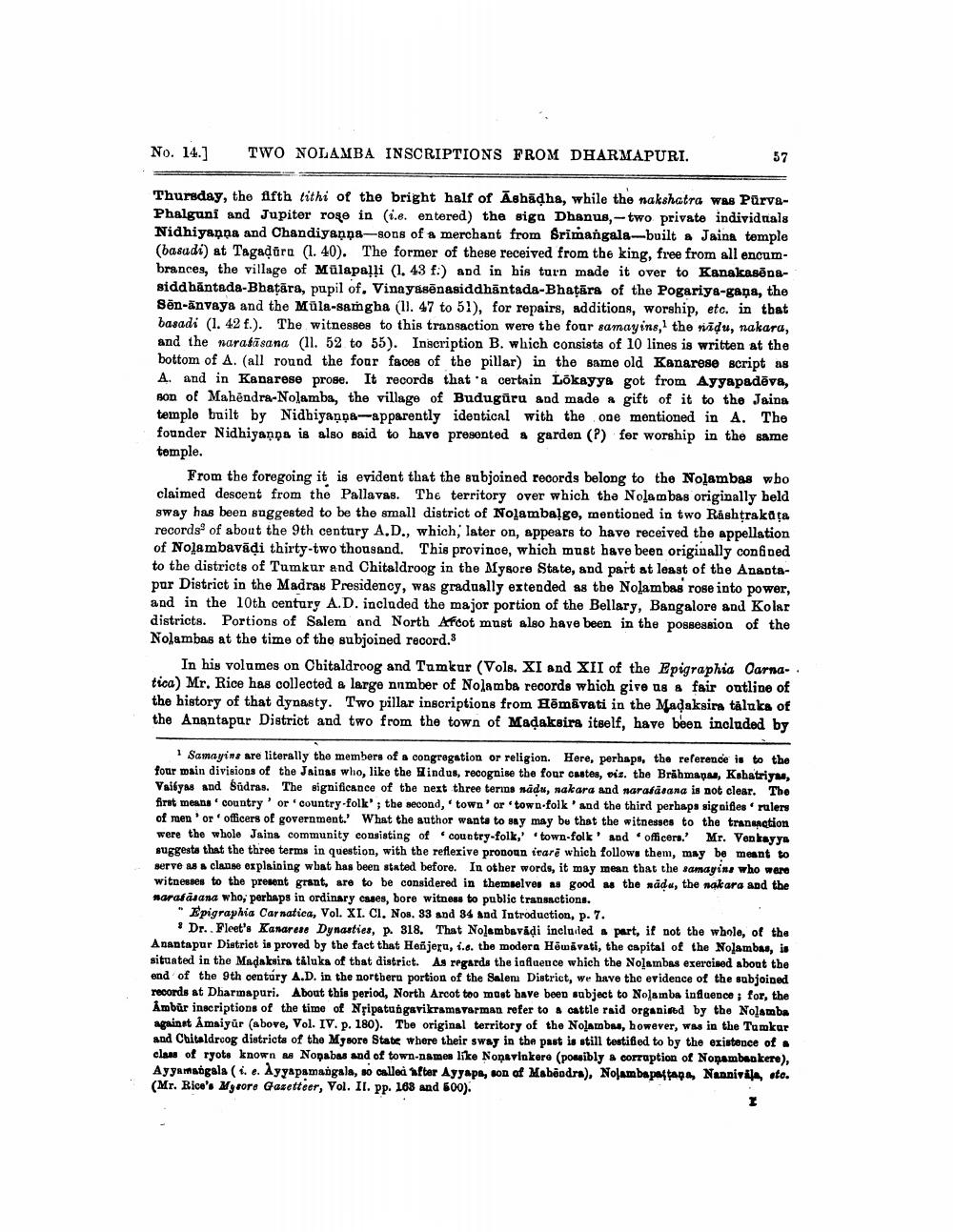________________
No. 14.]
TWO NOLAMBA INSCRIPTIONS FROM DHARMAPURI.
57
Thursday, the fifth tithi of the bright half of Āshādha, while the nakshatra was PurvaPhalguni and Jupiter roge in (i.e. entered) the sign Dhanus,-two private individuals Nidhiyanna and Chandiyaņņa-ons of a merchant from Srimangala-built a Jaina temple (basads) at Tagadura (l. 40). The former of these received from the king, free from all encumbrances, the village of Mülapalli (1. 43 f.) and in his turn made it over to Kanakasēnasiddhantada-Bhatāra, pupil of, Vinayásēnasiddhantada-Bhatārs of the Pogariya-gana, the Sēn-anvays and the Mula-samgha (ll. 47 to 51), for repairs, additions, worship, etc. in that basadi (1. 42 .). The witnesses to this transaction were the four samayins, the widu, nakara, and the narasāsana (11. 52 to 55). Inscription B. which consists of 10 lines is written at the bottom of A. (all round the four faces of the pillar) in the same old Kanarese script as A. and in Kanarese prose. It records that a certain Lokayys got from Ayyapadēva, son of Mahendra-Nolamba, the village of Budugūru and made a gift of it to the Jains temple built by Nidhiyaņņa-apparently identical with the one mentioned in A. The founder Nidhiyana is also said to have presented a garden (?) for worship in the same temple.
From the foregoing it is evident that the subjoined records belong to the Nolambas wbo claimed descent from the Pallavas. The territory over which the Nolambas originally beld sway has been suggested to be the small district of Nolambalge, mentioned in two Rashtrakata records of about the 9th century A.D., which, later on, appears to have received the appellation of Nolambavādi thirty-two thousand. This province, which must have been originally confined to the districts of Tumkur and Chitaldroog in the Mysore State, and part at least of the Anaptapur District in the Madras Presidency, was gradually extended as the Nolambas rose into power, and in the 10th century A.D. included the major portion of the Bellary, Bangalore and Kolar districts. Portions of Salem and North Arcot must also have been in the possession of the Nolambas at the time of the subjoined record.
In his volumes on Chitaldroog and Tumkur (Vols. XI and XII of the Epigraphia Oarna- . tica) Mr. Rice has collected a large nnmber of Nolamba records which give us a fair outline of the history of that dynasty. Two pillar inscriptions from Hēmāvati in the Madaksira tálaks of the Anantapur District and two from the town of Madaksira itself, have been included by
Samayins are literally the members of a congregation or religion. Here, perhaps, the reference is to the four main divisions of the Jainas who, like the Hindus, recognise the four castes, pis. the Brahmapa, Kshatriya,
ras. The significance of the next three terins nads, nakara and narafanana is not clear. The first means country or country-folk'; the second, town or town.folk' and the third perhaps signifies ralers of men or officers of government. What the author wants to say may be that the witnesses to the transaction were the whole Jains community consisting of country-folk,' 'town-folk' and officers. Mr. Venkayya suggests that the three terms in question, with the reflexive pronoun ivarē which follows them, may be meant to serve as a clanse or plaining what has been stated before. In other words, it may mean that the samayins who were witnesses to the present grant, are to be considered in themselves as good as the nada, the nakara and the warafasana who, perhaps in ordinary cases, bore witness to public transactions.
"Epigraphia Carnatica, Vol. XI. CI. Nos. 33 and 34 and Introduction, p. 7.
. Dr. Fleet's Kanaress Dynasties, p. 318. That Nolambsvidi included a part, if not the whole of the Anantapur District is proved by the fact that Henjera, i... the modera Homivati, the capital of the Nolambas, is situated in the Madaksira täluka of that district. As regards the influence which the Nolambas exercised about the end of the 9th century A.D. in the northern portion of the Salen District, we have the evidence of the subjoined records at Dharmapuri. About this period, North Arcot too must have been subject to Nolamba influence ; for, the Ambür inscriptions of the time of Npipatungavikramsvarman refer to a cattle raid organimd by the Nolamba against Åmsiyûr (above, Vol. IV. p. 180). The original territory of the Nolambas, however, was in the Tumkar and Chitaldroog districts of the Mysore State where their sway in the past is still testified to by the existence of . class of ryots known as Nomabas and of town-names like Noņsvinkere (possibly & corruption of Nonambeskere), Ayyamsógala (... Ayyapamangala, so called after Ayyape, son of Mabeodra), Nolambapastad, Nannivile oto. (Mr. Rice's Mysore Gazetteer, Vol. II. pp. 168 and 500).




